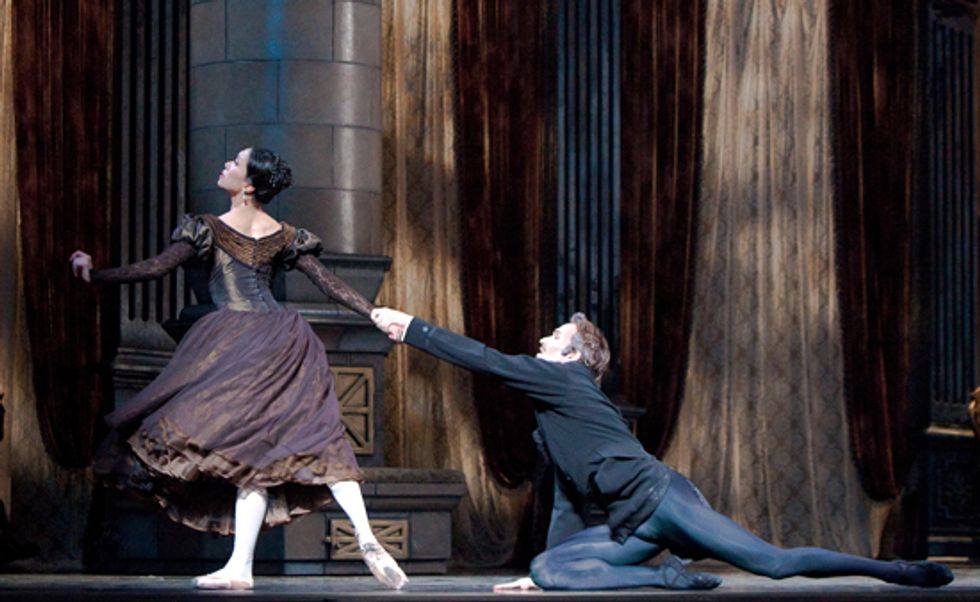Turning Into Tatiana
Cranko’s masterpiece Onegin is a ballet that does not seem to age. Pushkin’s story and Cranko’s brilliant telling of it find new audiences every generation. Dancers crave the responsibility to take it on and grow through its roles, and audiences keep going back again to witness the passionate turmoil of one of the most touching story ballets to date.
Onegin
has changed my life and continues to do so. As a young boy I saw it and instantly chose to embark on a path that would include the challenge to tell a story through dancing. This path eventually led me from Canada to Cranko’s own company in Stuttgart, which, given its rich history, cannot help but specialize in this sort of story ballet. I was promoted to soloist after dancing Onegin’s friend Lensky and then was appointed principal dancer while simultaneously being told I would dance the role of Onegin himself. I have had the privilege of learning from people who were the closest with John Cranko and knew his intentions.
Watching how each approached the Tatiana role gave me insight into the minds of each extraordinary woman who has danced it. Although Onegin is the title role, I recognize that it is Tatiana who drives the story forward. She pursues Onegin and it is also she who ultimately rejects him against her heart’s desire. Onegin’s drastic reactions depend on how she approaches the crucial moments in the ballet.
To shed some light on what it takes to prepare for this role, I decided to ask five ballerinas from around the world to share some of their thoughts on Tatiana.
“Very rarely does an opportunity arise to portray a character that is as beautifully envisioned as Cranko’s depiction of Tatiana,” says American Ballet Theatre’s Julie Kent. “She is a singular character because she is noble to the core.” The Stuttgart’s Alicia Amatriain adds, “I like to be able to play a part with as many human emotions and thoughts as this lady has. I just can’t imagine my life as a ballerina without her.” National Ballet of Canada’s Xiao Nan Yu was chosen from the corps to play the role before rising up through the company. She states, “Tatiana hits closer to home than any other dramatic role because this story could really happen to any woman with romantic yearnings. She is strong in her convictions and not fickle, but she is also a young girl at first. When I was first chosen to dance the part I could barely look at my partner in the eyes in rehearsals because I was so shy. I later realized that this is how Tatiana might have felt when first meeting Onegin.”
When I ask about the human qualities of the role, Kent mentions, “With this part a woman must be completely honest. It is important to do Tatiana justice by letting her own voice speak, and not the image you may have of yourself.”
Paris Opéra Ballet’s Aurélie Dupont can identify, saying, “At first I was frustrated by the restraint required to play Tatiana when Onegin hurts her badly and ignores her. As I was learning the steps I wanted to be more emotional in these initial scenes, but then I realized that this is how it is supposed to be. Only in the last pas de deux can this beautiful woman truly explode with all of her inner conflicts. I looked forward to that last 10 minutes of the ballet with such impatience!”
I figured that all five women had initially prepared by reading Pushkin and listening to Tchaikovsky (which they did). But I wanted to know what happened when they got into the studio to learn the choreography, which is quite athletic and acts as the “text” in the ballet. Dupont reflects, “The lifts are almost acrobatic to show Tatiana’s heightened emotions in the mirror pas de deux when she imagines Onegin there with her. At first I struggled to make it seem fluid, but when I danced the ballet again this year, I found that an organic approach with less force made the pas de deux more natural and very enjoyable.” On the physicality of the ballet Yu adds, “Of course, the partnering is Cranko, so it is challenging, but it makes so much sense with what one is feeling during those duets. The way the thoughts and lifts repeat themselves and return later on in the ballet again with a different maturity is so true to the story. There is a flow to it.”
When I inquire about the choreographic language Kent replies, “This ballet masterfully uses minimal ballet mime. From beginning to end, the steps clearly tell a story that is diverse in tone…from charming to starkly dramatic.”
In the studio we all work on making the partnering maneuvers seem seamless. As an Onegin, I have learned a lot about this while dancing the ballet. My colleague Amatriain states, “The woman also needs a lot of upper-body strength to be able to get the most out of the pas de deux in the first and third acts. Two people have to really become one.” Kochetkova can attest to that, saying, “Tatiana is completely drained by the end of this three-act ballet. I believe Cranko’s duets are unique because they take equal physical strength from the man and woman…though given the difficult lifts, I’m not sure my partner would agree.”
Onegin and Tatiana have a very intense relationship throughout the ballet, so naturally, I wanted to know if Julie, Xiao Nan, Aurélie, Maria, and Alicia had any desires about what they think makes the right Onegin for them. “I believe a good Onegin has had a past of some sort,” says Dupont. Kochetkova stresses the need for a connection on- and offstage. Amatriain says that to her the most important thing is simply finding a partner who is “able to truly share” with her. Yu says, “I like Onegin to have a dark side and be a true intellectual. He should be an incredible partner emotionally and physically.” Kent’s thoughts on the relationship are those of a seasoned ballerina: “Spontaneity and honesty are key in any performance that comes to life.”
Does Tatiana have sentimental value for some dancers? “Being Russian, it’s a wonderful experience to be able to work on a story which is so close to my culture,” says Kochetkova. “Unlike the other tragic heroines I’ve performed, like Lady of the Camellias, Juliet, or Manon, Tatiana doesn’t die at the end,” says Dupont. “Because of her deep obsession with romance I feel like one can see that she is already predisposed for heartbreak at the very beginning of the story. She starts off alone and ends alone.” Kent similarly adds, “The two main characters survive and are not reunited. This is very unusual for a ballet ending.” Amatriain recounts: “It feels more ‘real.’ This ballet really aims directly for the heart.” Yu says she loves that Cranko chose to end the ballet by having Tatiana all alone onstage. “It says so much about how sometimes doing the right thing in the face of passion can make one feel so alone. The curtain going down on Tatiana is one of the most striking images in ballet.”
Most Russians can reminisce about their favorite verses from Pushkin’s poem, and balletgoers in the parts of the world that Cranko touched can instantly recall their best-loved passages from Cranko’s ballet. “Onegin is a ballet for the soul,” says Kochetkova—to which Dupont adds matter-of-factly, “This piece and this particular character can touch anybody who has ever loved.”




